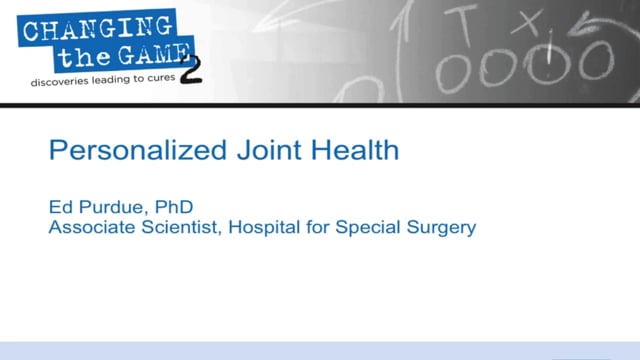
Ed Purdue, PhD
About Dr. Purdue
Cellular and Molecular Mechanisms Underlying Periprosthetic Osteolysis
Of the more than 168,000 patients who undergo hip replacement surgery every year in the U.S., as many as 20% require subsequent revision surgery due to aseptic loosening and periprosthetic osteolysis. The goal of the Osteolysis Research Laboratory is to develop, at the cellular and molecular levels, a better understanding of the events which lead to periprosthetic osteolysis. We are approaching this in four ways:
1. Firstly, we will be focusing on the roles of wear debris particles derived from the prostheses or bone cement in perturbing the complex intracellular signaling pathways within the cells around the prosthesis. It is known that macrophages within the periprosthetic membrane phagocytose these particles, and results from our laboratory have shown that this interaction between macrophage cells and particles can initiate pro-inflammatory cytokine signaling pathways, whilst concurrently inhibiting anti-inflammatory pathways.
2. In a second, related, project we are addressing the initial interaction of wear debris particles with receptors on the external surface of macrophages and other cells within the periprosthetic space. Our preliminary evidence is that different wear debris particles are recognized by different phagocytosis receptors on macrophages. Furthermore, opsonization patterns vary between particles of different compositions, and this will influence cell surface interactions.
3. We will complement our cell culture studies by directly examining revision tissues obtained from patients. Systematic analysis of these tissues by immunohistochemistry and in-situ hybridization is expected to provide important indicators of the mechanism of pathogenesis.
4. Finally, we are developing a mouse model for periprosthetic osteolysis. Currently used mouse models of osteolysis do not involve prostheses and do not target the effective joint space. The model under development at HSS involves introduction of bone cement particles around a titanium pin inserted into the tibia and, as such, is more closely analogous than other models to the human disease. Once optimized, we will use this model to test the involvement of key cytokines and other signaling molecules in wear debris induced osteolysis.
Videos

Publications by Dr. Purdue
Industry Relationships
One of the goals of HSS is to advance the science of orthopedic surgery, rheumatology, and related disciplines for the benefit of patients. Research staff at HSS may collaborate with outside companies for education, research and medical advances. HSS supports this collaboration in order to foster medical breakthroughs; however, HSS also believes that these collaborations must be disclosed. As part of the disclosure process, this website lists Research staff collaborations with outside companies if the Research staff member received any payment during the prior year or expects to receive any payment in the next year. The disclosures are based on information provided by the Research staff and other sources and are updated regularly. Current ownership interests and leadership positions are also listed. Further information may be available on individual company websites.
As of July 24, 2018, Dr. Purdue reported no relationships with the healthcare industry.
By disclosing the collaborations of HSS Research staff with industry on this website, HSS and its Research staff make this information available to patients and the public, thus creating a transparent environment for those who are interested in this information. Further, the HSS Conflicts of Interest Policy does not permit payment of royalties on products developed by him/her that are used on patients at HSS. Feel free to ask the Research staff member about their relationship(s).
